Walt Disney And Mickey Mouse Pictures
- "When people laugh at Mickey Mouse, it's because he's so human; and that is the secret of his popularity. I only hope that we don't lose sight of one thing — that it was all started by a mouse."
- ―Walt Disney[src]
Mickey Mouse is an animated character created by Walt Disney and Ub Iwerks. A cheerful and plucky anthropomorphic mouse, Mickey made his first public appearance in Steamboat Willie, on November 18, 1928. Estimated as standing 2' 3" (68.58 centimeters) and weighing 23 pounds (10 kilograms), Mickey is easily identified by his round ears, red shorts, white gloves, and yellow shoes. He speaks in a falsetto voice, and his speech is typically infused with 1930s slang like "swell" and "gee". The essence of Mickey's character is that of an underdog[28] [29] [30] who, despite being small and vulnerable, overcomes larger-than-life adversity through quick wit and a can-do spirit.
Mickey was popularized by his long-running short film series. His simplistic, "rubberhose" design allows for both relatable emotion, and exaggerated physical gags. Mickey's versatility, meanwhile, enables him to slip into any profession, location, or time period, while maintaining his core characteristics. Mickey steadily branched into other mediums over the years, beginning with a comic strip by cartoonist Floyd Gottfredson in 1930. In 1940, Mickey made his feature-length film debut with Fantasia, for which he was given his modern redesign by animator Fred Moore. In the 1950s, Mickey became a television mainstay with the premiere of The Mickey Mouse Club, as well as an icon for the Disney theme parks with the opening of Disneyland. Mickey has also featured prominently in critically acclaimed video games such as 1990's Castle of Illusion and the Kingdom Hearts series.
Upon his inception, Mickey rapidly rose to the pinnacle of American culture, becoming the most popular and recognizable cartoon character in the world, and the prime influence of following cartoons.[31] The character was especially treasured by Walt Disney, himself. The two were widely regarded as "alter-egos" by peers and historians,[32] [3] a perception supported by Walt originating Mickey's voice. Disney once attributed his success to the advent of Mickey, famously proclaiming that, "it was all started by a mouse".
As its most famous character, Mickey serves as the mascot of the Walt Disney Company. He has appeared in over 130 films, for which he received numerous accolades. In 1932, Walt Disney was presented an honorary Academy Award for the creation of Mickey Mouse.[33] In 1978, Mickey became the first animated character to receive a star on the Hollywood Walk of Fame. Today, Mickey stands as the highest-grossing animated character of all time, and the 4th highest-grossing media franchise overall.[34]
Contents
- 1 Background
- 1.1 Personality
- 1.2 Physical appearance
- 1.3 Voice
- 2 History
- 2.1 Creation; 1928-1930
- 2.2 1930-1950
- 2.3 1950-2000
- 2.4 2000-2020
- 2.5 2020-present
- 3 Film appearances
- 3.1 Hollywood Party
- 3.2 Fantasia
- 3.3 Fun and Fancy Free
- 3.4 Mickey's Once Upon a Christmas
- 3.5 Mickey, Donald, Goofy: The Three Musketeers
- 3.6 Mickey's Twice Upon a Christmas
- 3.7 Other films
- 4 Television appearances
- 4.1 Walt Disney anthology series
- 4.2 The Mickey Mouse Club
- 4.3 Bonkers
- 4.4 Mickey Mouse Works
- 4.5 House of Mouse
- 4.6 Mickey Mouse Clubhouse
- 4.7 Mickey Mouse
- 4.8 Mickey Mouse Mixed-Up Adventures
- 4.9 The Wonderful World of Mickey Mouse
- 4.10 Mickey Mouse Funhouse
- 4.11 Other shows
- 5 Printed material
- 5.1 Comics
- 5.2 Kingdom Keepers
- 6 Video games
- 6.1 Disney Heroes: Battle Mode
- 7 Disney Parks
- 7.1 Disneyland
- 7.2 Walt Disney World
- 7.3 Disneyland Paris
- 7.4 Tokyo Disney Resort
- 7.5 Hong Kong Disneyland
- 7.6 Shanghai Disneyland
- 7.7 Disney Cruise Line
- 8 Relationships
- 9 Filmography
- 10 Gallery
- 11 Trivia
- 12 References
- 13 External links
Background
According to Symphony Hour, "Mickey and the Culture Clash", and "The Fancy Gentleman", Mickey's full name is Michel Mouse. He has an older sister named Felicity Fieldmouse, by whom Mickey has twin nephews named Morty and Ferdie Fieldmouse, whom he occasionally watches over.
Mickey is normally depicted as living a modest life with his pet dog, Pluto. His earliest cartoons portrayed him as a country boy living in the midwest. The Adventures of Mickey Mouse: Book I—published in 1931—described Mickey as living "in a cozy nest under the floor of the old barn." As the shorts evolved, Mickey's residence was moved to the more urban settings of Hollywood, California, as seen in Mickey's Kangaroo and Mickey's Elephant. The official backstory of Disneyland's Mickey's Toontown plays into this, explaining that Mickey is of midwestern origins, but moved to Hollywood for the sake of his acting career. In the comics, Mickey's hometown is the city of Mouseton in the state of Calisota.
Mickey's longtime girlfriend is Minnie Mouse. According to Walt Disney, Mickey and Minnie are married in private life and are merely depicted as dating onscreen.[35] Despite their long-term relationship, Mickey has occasionally vied for Minnie's affections against her ex-boyfriend, Mortimer Mouse.
Mickey's occupational status is dependent on the story, but he is usually depicted as a jack-of-all-trades, working as anything from a steamboat deckhand to a sorcerer's apprentice. The most recurring employer of Mickey's is the Ajax Corporation, where he has worked alongside his best friends, Donald Duck and Goofy. Ajax consists of a variety of odd jobs (ghost exterminators, car washers, rollercoaster painters, etc.) and most of Mickey's assignments result in failure due to his and his team's incompetence. In comic stories, Mickey has frequently been portrayed as a detective working closely with his friend Horace Horsecollar and the Chief of Police, Chief O'Hara.
Though not for pay, Mickey has been a regular contributor to his local orphanage—which houses hundreds of nameless mice children. With help from Minnie, Donald and other friends, Mickey has organized numerous benefits for the orphans such as picnic outings and theatre shows. In some cartoons, he and Pluto have even welcomed the orphans into their home.[36]
In some continuities such as that of Darkwing Duck, A Goofy Movie, and numerous meta Disney productions like House of Mouse, Mickey is portrayed as an A-list celebrity made famous by his theatrical cartoon shorts, which are said to be based on real events in his life.
Concerning his in-universe age, Mickey is depicted as being relatively young. The official character training video for Disneyland (recorded in the 1970s) describes him as "an average young boy of no particular age."[37]
Personality
- "Mickey's a little bit in your face. Mickey's like, 'Hey! I'm smart, I can do anything, I get into trouble, but I can get out of it... I'm sort of rebellious, you know. I live by my own rules.' He's an adolescent dream, is what he is. Rebelling and making it work, that's Mickey."
- ―Writer Ron Suskind during the American Experience: Walt Disney special on PBS
Steamboat Willie establishes Mickey's core characteristics. He is cheerful in spirit, yet roughish in complexion. He ignored the commands of his overbearing boss for the sake of gallivanting around the steamboat. His mentality mirrored that of a rebellious child, as he mocked his superiors and threw a tantrum when others rebuked his merriment. Though impishly self-serving, he showed empathy and chivalry by forgoing protocol to aid Minnie during her time of need. With an air of valiance in spite of his diminutive stature and put-upon background, Mickey is an underdog with a heart of gold. By the high society denizens seen in Society Dog Show, Mickey is regarded as riff raff. In The Klondike Kid, Mickey describes himself as "a nobody". Pete often refers to Mickey as "Runt", a derogative term meaning an undersized or weak person. Regardless, Mickey remains jovial. His rebellious and independent mien allows him to take his downtrodden lot in life in stride with a smile and laugh.
Walt Disney once explained that elements of Mickey's character were derived from comic actor Charlie Chaplin, stating, "I think we were rather indebted to Charlie Chaplin for the idea. We wanted something appealing and we thought of a tiny bit of a mouse that would have something of the wistfulness of Chaplin ... a little fellow trying to do the best he could."[38] Iwerks described Mickey's characterization as having been inspired by Douglas Fairbanks. Iwerks once wrote, "He was the super-hero of his day, always winning, gallant and swashbuckling. Mickey's action was in that vein. He was never intended to be a sissy, he was always an adventurous character. I thought of him in that respect, and I had him do naturally the sort of thing Doug Fairbanks would do."[39] In addition to Chaplin and Fairbanks, Disney has attributed the development of Mickey's personality to other Hollywood figures, as well, such as Fred Astaire and Harold Lloyd.
With limited resources to his name, Mickey's greatest attribute is his wit. He is a thinker and schemer, being able to construct quick plots and ploys to advance his ambitions. This is prominently displayed in times of crises, in which Mickey must come up with hasty solutions to rescue his friends from such perils as natural disasters, or his nemesis Pete.[40] When paired with Donald and Goofy, Mickey serves as the resourceful "brains" of the trio by coming up with the plans and directing his companions to their desired goals. However, Mickey's schemes are often hindered by his own clumsiness and reckless abandon. Though he presents himself as slick and confident, Mickey is awkward and bumbling in actuality. In Fantasia, Mickey carried himself with a mighty air while donning Yen Sid's sorcerer hat, but fumbled with his oversized clothing and bungled his magic spells. He enjoys dressing in dapper attire to imitate high society as seen in such cartoons as Mickey Steps Out and Mickey's Delayed Date, only to trip over himself while showing off. When exposed for the little guy he is, Mickey's typical response is a sheepish, self-reflecting grin.
Even with his foibles, Mickey retains a can-do spirit that allows him to smile in the face of danger and move pass his mistakes. He gets by through optimism and has a positive outlook on the world and himself, often displayed by his jovial demeanor. Mickey's optimism is a double-edged sword, however, as while it pushes him to pursue his goals, it also causes him to underestimate trouble under the belief that he can do anything. In "Mickey's Piano Lesson", in fact, he justified his insolence by arrogantly proclaiming, "I'm Mickey Mouse!". Mickey is quick to share his positivity with others, to keep their spirits high during low times.[41] At times, Mickey's buoyancy can be invasive. In such cartoons as "The Adorable Couple", he attempts to force his positive demeanor onto Donald and Daisy, to disastrous results.
For all his juvenile mischief, Mickey is a reliable leader. When put in charge of a production, for example (such as a stage show or the House of Mouse nightclub theater) he is professional and composed, even when inconveniences get in the way. In addition to being a strong leader, Mickey is a devoted friend. He has, on numerous occasions, risked his life for the safety of others while never expecting recompense. This is most prominently seen with Minnie, for whom Mickey has often felt inclined to sacrifice his own happiness as seen in Mickey's Once Upon a Christmas. He is charitable and selfless, looking out for the less fortunate despite often being in undesirable predicaments, himself. In Mickey's Good Deed, Mickey sold Pluto to a wealthy household and used the money to supply a poor family with food and Christmas gifts—despite being homeless and hungry, himself. In Epic Mickey, Mickey sacrificed his only chance of escaping the Wasteland to rescue Oswald and Gus from danger, both of whom he had just met. A hero at his core, Mickey takes charge without second thought when trouble arises. In such cartoons as Gulliver Mickey and Runaway Brain, he fearlessly fought against monsters to protect the people around him.
Occasionally, Mickey can be too caring towards others, which can drive him to disregard his own needs.[42] At times, his empathetic heart blinds his better judgment, resulting in Mickey being taken advantage of by malicious forces.[43] There have also been instances where Mickey's desire to help can be excessive to the point of being intrusive, thus causing even more trouble in the long run.[44]
Mickey's temper can be rather explosive after being pushed to a certain limit.[45] When faced with his two most frequent adversaries, Pete and Mortimer Mouse for example, Mickey tends to act irritable and churlish. He is also relentless when it comes to getting back at his foes for their harassment.[46] In some cases, instead of outright giving his enemies satisfaction by losing his temper, Mickey would resort to sly pranks and trickery to best his foes—this being a way to one-up them, while also getting in a few laughs at the same time.[47] Because of his laid-back nature, however, Mickey is usually remorseful after letting his anger get the best of him, and does all that he can to remedy affected feelings, if any.[48]
Mickey evidently struggles with insecurity to some extent. In "Goofy for a Day", he panicked at the prospect of losing his hosting job at the House of Mouse, believing "show business" is the only profession that he's actually good at. His popularity seems to act as a double-edged sword. While he typically enjoys the attention, Mickey also feels a sense of pressure from the public to always be at his very best. This is most notably seen when Mickey is tasked with hosting live entertainment in front of a large audience. In which, he becomes short-fused and anxious.[49] [16] His insecurities are also apparent in his relationship with Minnie, as Mickey has repeatedly gone to great lengths to impress her—typically out of fear of losing her, as seen in "Mickey's Rival Returns" and "Mickey Tries to Cook". Some cartoons suggest that Mickey has commitment issues. In "A Midsummer Night's Dream", Mickey exclaims, "I just had the scariest dream!" after waking from a dream in which he married Minnie. The cartoon Mickey's Nightmare highlighted Mickey's apprehensions regarding parenthood.
In spite of being an anthropomorphic mouse, Mickey has the tendencies to act with his animal nature, including the fact that being a mouse, he loves cheese. In the television series House of Mouse, Mickey, being a mouse, is made fun of when he is shown to exercise on a hamster wheel and drink from a rodent drinking bottle (like the ones found in a hamster cage). These particular facts seem to only exist in the House of Mouse and haven't been shown again, proving to have been used for brief gags only.
Physical appearance
As designed by Ub Iwerks, Mickey's body was primarily comprised of circles and soft, rounded shapes. Mickey's most notable physical features are his ears, which are always depicted as circular from every angle. Mickey's 3-circle silhouette has become a well-known emblem of the character and an established symbol in pop culture. Originally, Mickey's face was a plain white color. When Fred Moore redesigned the character, Mickey's face adopted a Caucasian-toned hue.
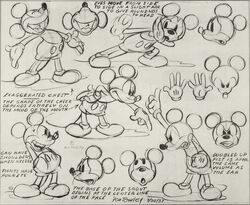
A model sheet of Mickey Mouse by animator Don Towsley. (c. 1937).
One of the most significant changes to Mickey's design were his eyes. They were originally drawn as blackened ovals, which moved across the entirety of his face to convey looking in different directions. For a brief period of time, beginning in The Karnival Kid, Mickey was drawn with "pie eyes" to create the illusion of light reflection. For Moore's redesign, pupils were added to Mickey's eyes to allow for more expression in the character animation. In Kingdom Hearts III—which adds further detail to the character models through computer animation—Mickey is depicted with blue irises.
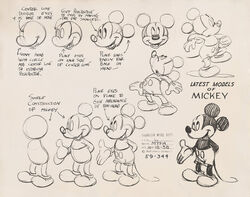
A model sheet of Mickey Mouse's redesign by animator Fred Moore. (c. 1938).
Mickey is diminutive in stature, standing at roughly 2 ft. He had a portly figure through the mid-1930s. In the Moore redesign, Mickey's body became a slimmer, pear shape. He is traditionally depicted as wearing a pair of red shorts with two white buttons on the front. In some instances, two additional buttons appear on the back of the shorts. Occasionally—as was the case in Parade of the Award Nominees—Mickey's buttons are instead colored yellow. When not wearing his usual shorts, red typically endures as Mickey's primary color motif (as seen in The Band Concert and Clock Cleaners).
Since The Opry House in 1929, Mickey has worn a pair of white opera gloves. Also known as "Toon Gloves", the garments were added to Mickey's ensemble as a means of distinguishing his hands from his black-furred body. In the first of Mickey's colored cartoons, his gloves were yellow. Mickey sports only three fingers and a thumb, which was a conscious choice by Walt Disney and his animators. Disney once stated, "Artistically, five digits are too many for a mouse. His hand would look like a bunch of bananas. Financially, not having an extra finger in each of 45,000 drawings that make up a six and one-half minute short has saved the studio millions."[50]
Mickey's traditional ensemble is completed by a pair of large, yellow shoes, which first appeared in The Gallopin' Gaucho. Initially blocky in design, Mickey's shoes adopted a somewhat plush appearance over time, being pliable with rounded edges. For a period of time in the 1940s, the shoes were instead colored brown.
Voice
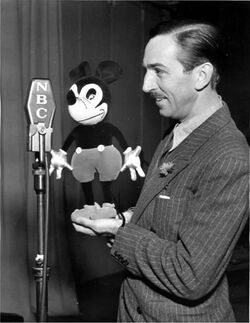
Walt giving voice to Mickey for NBC's "The Mickey Mouse Theater of the Air".
A large part of Mickey's screen persona is his falsetto voice, which was originated by Walt Disney. Walt had provided the unintelligible vocal effects for Mickey in Steamboat Willie. The "dialogue" featured in the short was an assortment of squeaks, yelps, and squawks akin to an actual mouse. Prior to Steamboat Willie, Mickey was a pantomime character who occasionally communicated with onscreen text (such as "Ha ha" in The Gallopin' Gaucho). When subsequent shorts required substantial dialogue for the character, finding a voice for Mickey proved difficult as "nobody knew what a mouse would sound like", Walt recalled. Disney would declare that Mickey's voice should be in a falsetto, and would demonstrate the sound to his animators. Walt was eventually confronted with the question, "Well, why don't you do it?". Disney thusly assumed the role, once joking that, "I knew it'd always be on the payroll, so I did it."[51]
Walt took great personal pride in voicing Mickey, and his performance established the character's personality. Some of Disney's gestures and mannerisms were imbued into Mickey's onscreen acting—most famously in The Pointer. According to Frank Thomas, Walt became very animated when behind the microphone, and would physically act out Mickey's scenes while recording.[52] Walt also had a hand in writing the scripts, particularly when it came to Mickey's dialogue. As the voice of Mickey, Walt would regularly record alongside other voice artists in the studio. Marcellite Garner—the voice of Minnie Mouse—recalled in an interview that Walt would take time out of their sessions to act out the parts and describe the scenes.[53]

Disneyland in CinemaScope!
An example of one of Walt's post-1947 performances as Mickey's voice.
By 1947, Disney was becoming too busy with running the studio to do regular voice work (and as it is speculated, his cigarette habit had damaged his voice over the years). As such, he could no longer commit to voicing Mickey. This change was notable onscreen, as Mickey's voice had deepened significantly in later shorts, due to Disney's own voice having deepened with age. After recording the Mickey and the Beanstalk section of Fun and Fancy Free, Mickey's voice was handed over to veteran Disney sound effects artist and voice actor Jimmy MacDonald. MacDonald voiced Mickey in the remainder of the theatrical shorts and for various television and publicity projects. Despite MacDonald's casting, Walt would reprise Mickey's voice on rare occasions, such as in the animated introductions to the original 1954—1959 run of The Mickey Mouse Club, "The Fourth Anniversary Show" episode of the Disneyland TV series, and Disneyland USA at Radio City Music Hall in 1962.
Carl Stalling voiced Mickey in The Karnival Kid in 1929. Clarence Nash voiced Mickey in the 1934 short The Dognapper, which would also be the only time that Nash voiced him.[54] [55] Walt was traveling in Europe at the time and was unavailable to record his lines for Mickey. J. Donald Wilson, Joe Twerp, and John Hiestand provided the voice of Mickey in the 1938 broadcasts of The Mickey Mouse Theater of the Air.[56] [57] Stan Freberg voiced Mickey in the 1954 Disney record album Walt Disney's Mickey Mouse's Birthday Party.[58] Alan Young voiced Mickey in An Adaptation of Dickens' Christmas Carol, Performed by The Walt Disney Players in 1974, which would be the first and only time that Young voiced him.[59] [60]
Les Perkins voiced Mickey in two TV specials in the mid-1980s: Down and Out with Donald Duck and DTV Valentine. Pete Renaday voiced Mickey in many 1980s Disneyland Records productions, including the Disney albums Mousercise, Mickey Mouse Splashdance and Yankee Doodle Mickey, along with several Disney Read-Along titles.[61] [62] He also provided his voice for The Talking Mickey Mouse toy in 1986.[63] [64] Jack Wagner was the voice of Mickey Mouse and several other characters in Disney Parks in the 1980s.
1983's Mickey's Christmas Carol marked the theatrical debut of Wayne Allwine as Mickey Mouse. Allwine, who would serve as Mickey's official voice actor from 1977 until his death in 2009, once recounted something MacDonald had told him about voicing the character: "The main piece of advice that Jim gave me about Mickey helped me keep things in perspective. He said, 'Just remember kid, you're only filling in for the boss.' And that's the way he treated doing Mickey for years and years. From Walt, and now from Jimmy." Allwine was, incidentally, married to Russi Taylor, who was the voice of Minnie Mouse from 1986 until her death in 2019.
Bret Iwan, a former Hallmark greeting card artist, is the current voice of Mickey, having taken over the role after Wayne Allwine's passing. His earliest recordings in 2009 included work for the Disney Cruise Line, various Mickey toys, the Disney theme parks, Disney on Ice: Let's Celebrate!, and Kingdom Hearts: Birth by Sleep.
Despite Iwan being Mickey's official voice actor, the character's voice is provided by Chris Diamantopoulos in the Mickey Mouse series, which premiered in 2013. Diamantopoulos was brought onto the role as the producers wanted Mickey's voice to more closely emulate Walt's performance. Since the premiere of Mickey Mouse, Diamantopoulos has reprised the role for numerous projects, including Wonderful World of Animation, the DuckTales episode "Moonvasion!" (as a watermelon shaped like Mickey's head), Mickey's Mix Magic, Mickey and Minnie's Runaway Railway, and The Wonderful World of Mickey Mouse.
History
Creation; 1928-1930
- "He popped out of my mind onto a drawing pad 20 years ago on a train ride from Manhattan to Hollywood at a time when the business fortunes of my brother Roy and myself were at lowest ebb, and disaster seemed right around the corner"
- ―Walt Disney in his 1948 essay, "What Mickey Means to Me"
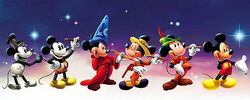
Mickey's evolution over the years from 1928 to the present.
On March 4, 1927, Walt Disney signed a contract with Universal Pictures to produce a series of cartoons starring his character Oswald the Lucky Rabbit, under the authority of producer Charles Mintz. With animation being headed by Disney's longtime collaborator Ub Iwerks, the Oswald series was a hit with audiences. As the series gained traction, however, the partnership between Disney and Universal quickly began to fall apart. Walt was informed by Iwerks that Mintz's assistant, George Winkler, had been hiring away Disney's animators behind his back. When Disney traveled to New York to negotiate a more profitable contract in 1928, Mintz instead proposed a 20% cut. Rather than accept Mintz's deal, Disney quit the Oswald series. On the train ride back to California, Walt desperately brainstormed ideas for a new cartoon character, in order to keep his studio afloat. He would eventually conceive a mouse character. Disney believed that a mouse would make for a cute and sympathetic character. He also felt that mice hadn't been overused in motion pictures, allowing for Mickey to stand out against the competition of the time. Walt would name his new character "Mortimer Mouse". His wife, Lillian Disney, disliked the name and instead suggested "Mickey Mouse".[65]
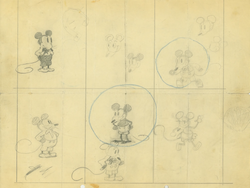
Concept art of Mickey from early 1928; the sketches are the earliest known drawings of the character, from the collection of The Walt Disney Family Museum.
Walt created a sketch to get the basic idea of the character, and later shared it with Ub, who refined it. Mickey's model greatly resembled that of Oswald and other animal characters of the time, such as Otto Messmer's Felix the Cat. Iwerks would explain, "Pear-shaped body, ball on top, a couple of thin legs. You gave it long ears, and it was a rabbit. Short ears, it was a cat. With an elongated nose, it became a mouse." Along with Ub and a few other loyalists, Disney worked on the first two Mickey cartoons in secret, while simultaneously abiding to his contractual obligation to complete his final Oswald cartoons for Universal.
The first Mickey short to be produced was Plane Crazy, and it was first screened for test audiences on May 15, 1928. Plane Crazy focused on Mickey's attempt to become an aviator in emulation of Charles Lindbergh. In this short, Mickey was gloveless and shoeless. His appearance bore animalistic qualities more closely resembling an actual mouse than modern interpretations. In terms of personality, Mickey was portrayed as a rash and arrogant character, even going as far as to antagonize his love interest, Minnie Mouse. Plane Crazy failed to find a distributor, and was not released that year. The second-produced Mickey short, The Gallopin' Gaucho, was significant in introducing Mickey's trademark shoes, while also depicting the mouse as a more noble and heroic character. The short centered on Mickey embarking on a chase to rescue Minnie from the villainous Pete, which would become a recurring story thread throughout Mickey's career. However, The Gallopin' Gaucho also failed to make an impact with potential distributors and would not be released to the public that year.
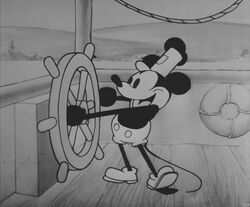
Mickey in his debut cartoon, Steamboat Willie.
It was then that Walt decided to take an extremely ambitious step by breaking into "talkies". Sound had been in animated cartoons before, but never on a scale quite like Mickey's third-produced short, Steamboat Willie. A parody of Buster Keaton's Steamboat Bill, Jr., the cartoon featured Mickey as the mischievous deckhand of a steamboat commanded by Pete. Towards the climax of the short, he conducts a performance of the song "Turkey in the Straw" with Minnie. Steamboat Willie reinvented Mickey's character with a more appealing design and relatable personality. In addition to writing the script, Walt provided the vocal performances of both Mickey and Minnie (he would continue to voice Mickey for decades to follow). Steamboat Willie was released on November 18, 1928 at Universal's Colony Theater in New York City, to critical acclaim. Though it was the third short to be produced, it was the first to be publicly released. As such, November 18th is recognized as the official birthday of Mickey Mouse, as declared by archivist Dave Smith in 1978. The opening sequence of the short—in which Mickey whistles the tune of "Steamboat Bill"—has served as the opening logo of Walt Disney Animation Studios films since 2007. The success of Steamboat Willie later allowed for the official releases of both The Gallopin' Gaucho and Plane Crazy, remastered with sound.
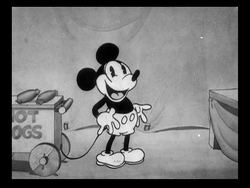
Mickey in The Karnival Kid, his first actual speaking role.
A slew of shorts would quickly follow, a majority of which portrayed Mickey as a rascally mouse living in a barn-like setting. The plots in Mickey's earliest cartoons were typically bare bones. Generally, the majority of the runtime was dedicated to musical sequences accompanied by rubberhose gags involving the characters and anthropomorphic objects. As more cartoons were released, Mickey's character would develop in significant ways—much of which occurred in the character's sophomore year of 1929. In The Opry House (released on March 28), Mickey was given his trademark gloves, which made him easier to animate. The Plowboy (released on June 28) introduced Horace Horsecollar, who would regularly appear as Mickey's steed and friend. Clarabelle Cow was depicted as Minnie's best friend, and became a recurring character in the films, alongside Horace. In The Karnival Kid (released on July 31), Mickey spoke his first words, "Hot dog!". The phrase would become the character's catchphrase in later shorts. In Mickey's Follies (released on August 28), Mickey performed the song "Minnie's Yoo Hoo", an instrumental version of which would become the theme song of his film series until 1933.
With Mickey's success all but assured, Disney was offered a deal—$300 in cash for the right to feature Mickey on a children's pencil tablet. Walt accepted, and thus began Mickey Mouse's foray into merchandising.[66] Furthermore, Disney created the original Mickey Mouse Club in 1929 for fans of his character and cartoons. Though the club had its start in the United States, it would later expand to overseas markets such as Europe and Australia. The club had over one million members. In June of 1929, J.V. Connelly of King Features Syndicate proposed the concept of a Mickey Mouse comic strip for newspapers.[67]
1930-1950
On January 30, 1930, the first of Mickey's printed adventures was distributed—as written by Walt Disney, and illustrated by Ub Iwerks. Dubbed "He's Going to Learn to Fly Like Lindy", the strip sees a barn-dwelling Mickey dreaming about becoming an aviator like Charles Lindbergh. By the summer of 1930, the comic had appeared in up to 40 newspapers across the world. By May of that year, Mickey's comic stories were taken over by Disney artist Floyd Gottfredson, who would become renowned for four decades worth of work on Mickey Mouse comic stories. Like Mickey's entry into merchandising, the Mickey Mouse strip is credited to having attributed to Mickey's "golden age" and worldwide success.[68] That same year, The Chain Gang introduced a non-anthropomorphic bloodhound character who would evolve into Pluto, Mickey's pet dog and a frequent supporting character in the films.
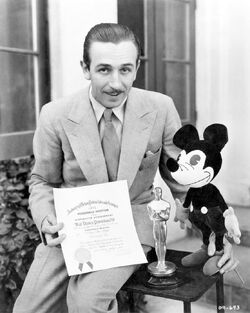
Walt Disney's Honorary Academy Award for the creation of Mickey Mouse (1932).
At the 5th Academy Awards in 1932, Mickey received his first nomination for Mickey's Orphans. At the same ceremony, Walt was awarded an Honorary Academy Award in recognition of Mickey's creation. Coming off the success of Disney's Technicolor Silly Symphonies cartoon Flowers and Trees (which won the Academy Award that year, beating Mickey's Orphans), Mickey's first appearance in color was in Parade of the Award Nominees, a short created for the 5th Academy Awards banquet. As a result, it was not released to the public. In his first animated appearance in color, Mickey donned green shorts, yellow gloves, and shoes. Despite this, Mickey continued to appear in black and white films moving forward. One of which, Mickey's Revue, introduced the character Dippy Dawg, who would evolve in Mickey's friend Goofy.
The Disney artists indulged in Mickey's popularity by producing Mickey's Gala Premiere in 1933 (which paired Mickey with numerous A-list Hollywood stars). On June 1, 1934, Mickey briefly appeared in Hollywood Party opposite Jimmy Durante—the only animated character to appear in the crossover picture. That same year, Mickey made his debut in the Macy's Thanksgiving Day Parade, and was the third character from pop culture to have a licensed balloon. 1934 also introduced Donald Duck as Mickey's temperamental foil and companion. Donald was created in response to the many taboos being placed upon Mickey by audiences of the time. Donald allowed for Disney and his artists to give their films "a little attitude". Disney chose to pair Mickey and Donald together to add contrast to the shorts, with their first shared cartoon being Orphan's Benefit.[69]
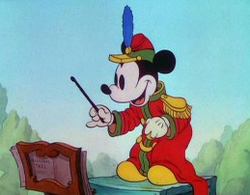
Mickey in The Band Concert, his first official cartoon in color.
It wouldn't be until 1935's The Band Concert, that Mickey was given his first official cartoon in color. The short depicted Mickey as the struggling conductor of a public band concert, with such nuisances as Donald Duck and a sudden tornado causing havoc throughout the performance. Despite the breakthrough, two more Mickey cartoons released that year in black and white. One of which was Mickey's Service Station, which is notable for being the first in a series of comedy films starring Mickey Mouse, Donald Duck, and Goofy together. The last of Mickey's black and white cartoons was Mickey's Kangaroo. With the introduction of color, Mickey's body structure was given a new look; his round body was replaced by a pear-shaped looking one and his head was changed so his nose was closer to his face. His ears were turned from round to oval and his eyes became more detailed (the pupils smaller, the eye itself outlined instead of partially open).
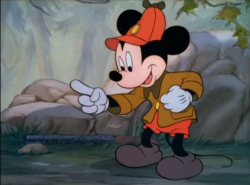
Mickey in his Fred Moore redesign in The Pointer.
As Mickey's fame grew, a segment of unhappy parents disapproved of the character's flawed behavior.[70] To appease the demographic, Mickey's later cartoons strayed away from the controversial gags and stories of the character's formative years. Consequently, the character's popularity declined steadily throughout the late '30s. He was even omitted from a number of the Mickey, Donald, and Goofy shorts, beginning with 1938's Polar Trappers. To boost Mickey's relevance, Walt envisioned, "an advancement in the sophistication of Mickey's roles and acting ability." To allow a broader range of emotion in the character animation, Fred Moore was brought on to redesign Mickey. In 1936, with Mickey's new design in place, Walt began early development on a deluxe short titled The Sorcerer's Apprentice, based on the 1797 poem by Johann Wolfgang von Goethe, and its 1897 orchestral adaptation by Paul Dukas. Starring Mickey as the titular apprentice, the piece was conceived as a cross between animation and classical music—not unlike Disney's Silly Symphonies. While development was underway for Sorcerer, Fred Moore's redesign of Mickey would appear in 1939's Mickey's Surprise Party, and The Pointer; the latter of which went on to receive an Academy Award nomination.
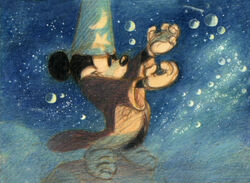
Concept art of Mickey as the sorcerer's apprentice.
The Sorcerer's Apprentice's production cost ballooned to $125,000—three to four times greater than the usual Silly Symphony, according to producer Ben Sharpsteen. Knowing that The Sorcerer's Apprentice would not make back its budget, talks began in 1938 to expand the project and produce a full-length feature, of which The Sorcerer's Apprentice would be a segment.[71] This would evolve into Fantasia, which would become Disney's third animated film, following the critical successes of Snow White and the Seven Dwarfs in 1937 and Pinocchio in 1940. While the film is lauded today as a cinematic masterpiece, Fantasia was a financial and critical disappointment upon release in 1940. Rather than make a comeback as Walt had intended, Mickey would continue to decline. There were several contributing factors to Mickey's decline. For one, it was perceived that the essence of Mickey's character was too subtle and human for most storymen to capture accurately—the one exception being Walt Disney, himself. However, Walt had become too preoccupied with feature films to contribute to the shorts. Animator Ollie Johnston would explain, "The story guys were not capable of doing a Mickey story without Walt. He was the only one who could get the feeling of that personality."[72] In a 1949 interview, Disney stated, "Mickey's decline was due to his heroic nature. He grew into such a legend that we couldn't gag around with him. He acquired as many taboos as a Western hero—no smoking, no drinking, no violence."[73]
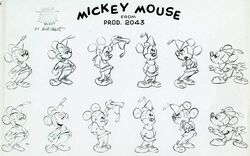
A model sheet of Mickey for his second feature-length film, Fun and Fancy Free.
Mickey would continue to appear in noteworthy shorts, but these were few and far between. One of which included Lend a Paw, which became the only Mickey Mouse cartoon to date to win an Academy Award, having won for Best Animated Short of 1941. Around the same time, an effort was made within the studio to develop a full-length feature film starring Mickey Mouse. Animators Bill Cottrell and T. Hee pitched the idea of a feature film based on Jack and the Beanstalk, with Mickey in the role of Jack. In response to the pitch, Walt, "burst out laughing with tears rolling down his cheeks with joy", as Cottrell and Hee later recalled. Though Disney enjoyed it, he claimed that Cottrell and Hee, "murdered [his] characters", and thus rejected the pitch. Cottrell and Hee eventually coerced Walt into giving the greenlight, and after much delay in 1947, Mickey made his second feature film appearance, as the protagonist of the Fun and Fancy Free segment, Mickey and the Beanstalk. The feature would mark the first performance of Jimmy MacDonald as Mickey, who provided the character's voice for the film in tandem with Walt.
1950-2000
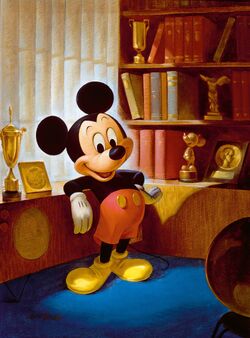
John Hench's depiction of Mickey in 1953's 25th anniversary portrait.
In the final years of Mickey's original theatrical run, Disney's cartoon shorts were given a "modernized" style of animation that Disney used from the mid-1950s to the later 1960s. Mickey, himself, was given eyebrows in his redesign. Eyebrows would continue to be seen on Mickey's face until the late 1980s and rarely in the early 1990s, until being removed altogether. There were 56 more color cartoons in the original Mickey Mouse theatrical series. The last of which was The Simple Things in 1953, which focused on Mickey and Pluto's day at the beach.
Afterward, Mickey's series would receive a thirty-year hiatus. Although he no longer appeared in theatrical cartoons, Mickey would maintain some degree of relevance by remaining the face of the Disney company, specifically in merchandising. In 1953, Disney commemorated Mickey's 25th anniversary with a portrait depicting the mouse by John Hench. This would be the first in a tradition in which the Disney company would commission and release a portrait to coincide with a major anniversary of Mickey's. Hench would paint the portraits for 1978, 1988, 1998 and 2003. Following Hench's death, Paul Felix designed the portrait for 2008, while veteran animator Mark Henn designed the portrait for 2018. The portraits are currently residing at the Walt Disney Archives.
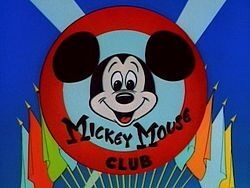
A 1950s stylized Mickey in the Mickey Mouse Club.
Perhaps most notably in the 1950s, Walt debuted the popular The Mickey Mouse Club television show (with follow-ups of the same name debuting in 1977 and 1989). In relation to Mickey, the show is perhaps most notable for introducing Jimmie Dodd's "Mickey Mouse March", which would go on to become Mickey's trademark theme song. It also marked the first appearance of the iconic Mouse Ear hats that would become staples in Disney theme parks, the first of which—Disneyland—opened the same year in 1955. Mickey was present for Disneyland's opening, and continues to serve as the park's "ambassador" to this day.
On November 18, 1978, in honor of his 50th anniversary, Mickey became the first animated character to have a star on the Hollywood Walk of Fame. The star is located at 6925 Hollywood Blvd. That same year, Mickey would appear at the 50th Academy Awards ceremony to help announce the winner for Best Short Film (Animated). Mickey would later go on to appear at the Academy Awards ceremonies of 1988 and 2003.

Title card artwork featuring Mickey as Bob Cratchit in Mickey's Christmas Carol.
In 1983, Mickey appeared in his first theatrical short since 1953's The Simple Things: Mickey's Christmas Carol, where he played the role of Bob Cratchit, opposite Scrooge McDuck's Ebenezer Scrooge. The short also marked the debut of Wayne Allwine, who would voice Mickey for three decades, until his death in 2009.
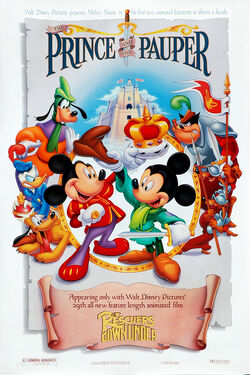
A poster for Mickey's 1990 featurette, The Prince and the Pauper.
As Mickey's 60th anniversary grew near in the late '80s, there was an initiative to bring classic Disney characters back into the spotlight via animated short productions. Several projects were planned, one of which included 1990's The Prince and the Pauper, which was screened in front of The Rescuers Down Under and featured Mickey starring in the (duo) lead role. Two additional Mickey projects were slated to release around this time, including the featurette Swabbies (1989), and a Christopher Columbus-inspired period piece titled Mickey Columbus (1992). Both cartoons were shelved, however.
Outside of fleeting cameos and references, Mickey was largely absent from the Disney Afternoon block that aired throughout the 1990s on Disney's television networks. However, Mickey was featured in the opening and closing sequences of the block, interacting with some of the characters from its series.
In 1994, four of Mickey's cartoons were included in the book The 50 Greatest Cartoons, which listed the greatest cartoons of all time as voted by members of the animation field. The films were The Band Concert (#3), Steamboat Willie (#13), Brave Little Tailor (#26), and Clock Cleaners (#27).
In 1995, Mickey starred in a new theatrical cartoon short titled Runaway Brain, where Mickey's brain and body gets switched with that of a monster who falls in love with Minnie. This short was originally screened in front of A Kid in King Arthur's Court.
Mickey and his friends received a major comeback with the premiere of the Mickey Mouse Works series of shorts in 1999, shepherd by Roy E. Disney (son of Roy O. Disney and nephew of Walt). Developed in the style of Disney's Golden Age of Animation, the show featured new cartoons starring Mickey, in which he embarked on comical misadventures often caused by his own mischief. Outside of his mainline shorts, Mickey also starred in the 90-second umbrella title Mickey to the Rescue, which followed Mickey's quest to rescue Minnie from Pete's lair. In the 12-minute long Mouse Tales cartoons, Mickey served as the protagonist in adaptations of classic stories.
2000-2020
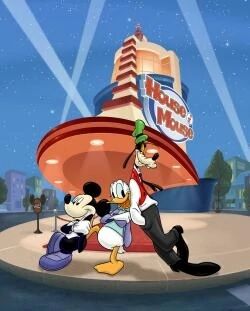
Promotional artwork of Mickey, Donald, and Goofy in House of Mouse.
Immediately after Mouse Works's conclusion, Mickey starred in House of Mouse—a crossover sitcom series in which Mickey manages a club frequented by various characters from Disney's history. House of Mouse ran for three seasons, and spawned two straight-to-DVD movies.
When development began for what would become the 2002 video game, Kingdom Hearts, developer Squaresoft wanted Mickey to serve as the game's protagonist—contrast to Disney's request to use Donald Duck. Director Tetsuya Nomura remedied the issue by creating the character Sora, who was inspired by Mickey. Despite only having a brief appearance in the original game, Mickey's role was greatly expanded in later entries to serve as the most significant Disney character in the franchise.
Mickey served as the Grand Marshal of the Tournament of Roses Parade on New Year's Day of 2005 as part of the kickoff of the "Happiest Homecoming on Earth", celebrating Disneyland's 50th Anniversary.
In 2004, Mickey starred in his first, non-compilation feature-length film, Mickey, Donald, Goofy: The Three Musketeers. A direct-to-video musical adaptation of the 1844 novel, the film follows Mickey, Donald and Goofy embarking on a quest to prove themselves as musketeers by rescuing Princess Minnie Mouse from the villainous Captain Pete. Three Musketeers was initially conceived in 1984 by storyboard artists Steve Hulett and Pete Young, and was to also feature José Carioca as the fourth musketeer, but this version never came to be.[74] [75] That same year on November 9, Mickey transitioned to computer animation with the release of Mickey's Twice Upon a Christmas.
2006 saw the premiere of the interactive children's show Mickey Mouse Clubhouse. The series was a massive success amongst younger audiences, and popularized Mickey's catchphrase ("Hot dog!") with "The Hot Dog Song" by They Might Be Giants. Clubhouse ran on Playhouse Disney and Disney Junior for four seasons, until its conclusion in 2016.
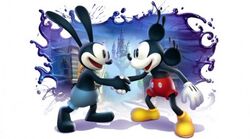
Artwork of Mickey meeting his predecessor Oswald in the Epic Mickey video game series.
In 2009, Mickey reappeared in the Macy's Thanksgiving Day Parade, dressed as the captain in Tugboat Mickey. That same year, Disney sought to rebrand the Mickey Mouse character again by putting less emphasis on his pleasant, cheerful side and reintroducing the more mischievous and adventurous aspects of his personality, beginning with the video game Epic Mickey. Though the game received mixed reviews, it was significant as the first onscreen interaction of Mickey Mouse and Oswald the Lucky Rabbit. 2009 also marked the debut of Bret Iwan as Mickey's official voice actor, succeeding the late Wayne Allwine. Unusual for a voice actor, Iwan has become a regular spokesperson for Disney, frequently appearing at promotional and fan events—most often covering the topics of Mickey and theme parks, among other experiences related to the company.
In 2010, three dozen Mickey statues were used to promote the Major League Baseball All-Star Game, which was played in Anaheim, California, adorned with insignias of the teams.
In 2011, Mickey and Minnie were appointed Grand Marshals of the 20th Annual Festival of Lights Parade in Chicago.
In 2012, Mickey played a silent supporting role giving a dress to Minnie in the animated short Electric Holiday, a collaboration between Disney and the Barney's New York fashion industry.
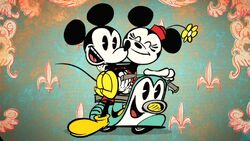
Paul Rudish's redesign of Mickey and Minnie for made-for-TV shorts.
In June 2013, Mickey and his friends were rebranded, once more, with the premiere of a new series of shorts (appropriately titled Mickey Mouse) headed by animator Paul Rudish. In the style of Mickey's earliest cartoons, the shorts highlight Mickey's more flawed personality traits while retaining his likability and wholesomeness. The series marks the debut of Chris Diamantopoulos as the voice of Mickey, who has since earned numerous accolades for his performance. With millions of views on YouTube, the series has garnered major acclaim; it has earned several Emmy and Annie Awards for its writing, music, voice work, and animation. Paul Rudish's take on Mickey has since been featured significantly in different facets of the Walt Disney Company, including theme parks, merchandise and social media outlets. Rudish's Mickey also serves as the current mascot of Disney Television Animation.
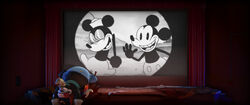
Mickey and Minnie triumph over Peg-Leg Pete in Get a Horse!
According to animation director Lauren MacMullan, there was a company-wide initiative to develop new ideas for classic Disney characters. MacMullan looked to the Ub Iwerks era of animation for inspiration, and would eventually conceive a hybrid traditional animation/CGI short Get A Horse! (released on November 27, 2013). In the short, Mickey is knocked out of the 2D world by Pete, who has once again kidnapped Minnie. With help from Horace Horsecollar, Mickey battles Pete to rescue Minnie, all the while being trapped in the 3D world. Get a Horse! was screened theatrically in front of Frozen, and featured archival recordings of Walt Disney as the voice of Mickey Mouse. It also earned Mickey his tenth Oscar nomination at the 86th Academy Awards.
Mickey's birthday celebrations in 2016 and 2017 involved a world tour in which Mickey interacted with fans and their culture. To coincide with the festivities, an original song titled "What We Got" by Tony Ferrari was released. In January of 2017, Mickey starred in a new children's show, Mickey and the Roadster Racers. Initially a madcap racing series, the show was later rebranded as Mickey Mouse Mixed-Up Adventures that focused on the various day-to-day hijinks of Mickey and his friends.

Mickey and his birthday cake as depicted in ABC's Mickey's 90th Spectacular.
2018 marked Mickey's 90th anniversary; Disney launched a company-wide celebration dubbed "Mickey: The True Original", which highlighted Mickey's impact on pop-culture since his inception in Steamboat Willie. On November 4th, ABC aired Mickey's 90th Spectacular, a two hour long television special centering Mickey's career. The gala included tributes, musical numbers and celebrity guest stars. From November 8th to February 10, 2019, New York City hosted a pop-up art exhibit dedicated to Mickey. The exhibit consists of ten interactive rooms and displays artists' recreations of various Mickey moments from over the years, as well as archived Mickey material such as concept art and merchandise. Similar exhibits were opened in Seoul, Hong Kong, Malaysia, Dubai and South Africa. Exclusive Mickey-themed merchandise from major brands such as Beats by Dre, Pandora and Vans were also released. There was also a book released called Walt Disney's Mickey Mouse: The Ultimate History, a large 496-page encyclopedia of Mickey's history from 1928 to the present.
2020-present

Mickey and Minnie as animatronics in their first ride-through attraction, Mickey and Minnie's Runaway Railway.
In 2020, Walt Disney World debuted the first Mickey Mouse-themed dark ride in the parks' history with Mickey and Minnie's Runaway Railway—based on Paul Rudish's shorts. In the attraction, Mickey appears in both the pre-show musical short and as an audio animatronic. The ride also marks the debut of the song "Nothing Can Stop Us Now", performed by Mickey and Minnie. On October 9, Mickey briefly appeared as a virtual guest at the fifth game of the NBA Finals, which was hosted at ESPN Wide World of Sports in Walt Disney World.[76] On November 18, Disney premiered Mickey's first made-for-streaming series on Disney+, The Wonderful World of Mickey Mouse. A successor to the Paul Rudish shorts, the series retains the same creative team and art style, with Chris Diamantopoulos reprising his role as Mickey.
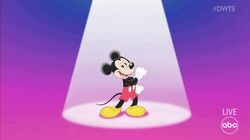
Mickey's cameo in Dancing with the Stars.
In 2021, Mickey made a guest appearance on Season 30 of ABC's Dancing With the Stars. The season's Disney Week introduced the Mickey Dance Challenge, a special dance created by Mickey that was then delivered to the couples to perform for bonus points. Mickey's cameo was created using traditional animation, as animated by Eric Goldberg. Goldberg had previously worked on Mickey for numerous projects, including theme park attractions and commercials.
Film appearances
Hollywood Party
In the 1934 feature film, an animated Mickey crashes the live-action environment of Jimmy Durante's house party, much to the shock of Durante and the other celebrities in attendance. Mickey mischievously mocks Durante, puts on a piano performance, and introduces the cartoon The Hot Chocolate Soldiers.
Fantasia
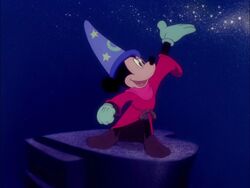
Mickey in his first feature film, Fantasia.
Mickey's most famous role (alongside Steamboat Willie) is in the 1940 film Fantasia. In the film, Mickey appears in a segment called "The Sorcerer's Apprentice". After the segment, he and Leopold Stokowski share a live-action/animated handshake, congratulating each other.
In this role, Mickey is the apprentice of a powerful sorcerer known as Yen Sid. Whilst the sorcerer spends his time conjuring spells and working with his abilities, Mickey merely works more as a servant, carrying buckets up a massive staircase to a well full of water. One night, however, after Yen Sid retires to slumber, Mickey sneaks on the sorcerer's hat, which appears to be the main source of his magic. Having enough of the physical labor, Mickey brings a broomstick to life with his new found magic and orders it to carry on his duties. It's a success, and the little mouse soon falls asleep, dreaming he is the world's greatest sorcerer. At first, he does not realize the broom continues to bring water to the well. So much, that the tower becomes flooded. Mickey tries to stop the broom, but it's no use, and the mouse is forced to kill it by cutting it to pieces with an ax. After the deed is done, Mickey begins to rest again, but the tiny pieces of sliced wood magically become hundreds of living brooms, and the army continues on with the duty of filling the overflown well with water, soon flooding the entire tower until Yen Sid arrives and puts an end to the chaos. After all seems well, Mickey silently apologizes and is ordered to return to his duties as punishment.
Fun and Fancy Free
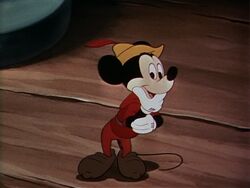
Mickey in Mickey and the Beanstalk.
Mickey, Donald, and Goofy live in a once peaceful village called Happy Valley, that became a wasteland after the beautiful singing Golden Harp was kidnapped by a mysterious giant. The friends nearly die of starvation, but Mickey went off to sell their prized cow for food. Instead of a meal, Mickey bought three magic beans from a peddler, which Donald in a fit of anger threw out of the house. The beans then grew into a beanstalk that led to the castle of Willie the Giant who is the kidnapper of the Harp. The three battle the giant to save the harp and restore the peace in their village. They rushed down the beanstalk with the harp, chopped it down once on the ground, and escaped safely. Mickey, Donald, and Goofy became heroes and peace is restored.
Mickey's Once Upon a Christmas
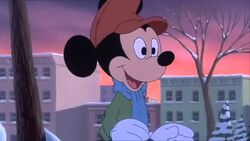
Mickey in Mickey's Once Upon a Christmas.
In this film, Mickey is lacking in money, preventing him from easily purchasing a chain for Minnie's watch as a Christmas gift. To gain money faster, he and Pluto work extra hard at their job at "Crazy Pete's Tree Lot". However, after ruining Pete's scheme to sell an overpriced tree to a struggling family, Mickey's tip money is stolen by Pete, and the mouse is fired.
With no money, Mickey and Pluto think of a way to make more money, whilst Mickey plays his beloved harmonica. The beauty of Mickey's harmonica playing catches the attention of the Chief of Police who is having a toy drive. However, the band for the drive was unable to perform at the time. The Chief asks Mickey to play at the drive, but Mickey tries to explain that he has no time. Upon seeing the sad face of a child who donates a toy, Mickey decides to play.
Even after his stellar performance, Mickey still has no way to get Minnie her gift. Before Mickey departs, the Chief congratulates Mickey on his performance and tells him that he and his harmonica are something special. This gives Mickey the idea to trade in his harmonica for Minnie's chain. The store owner doesn't accept the offer, however, until he hears Mickey's harmonica playing. Feeling sympathy for the mouse, the store owner goes through with the trade.
At Minnie's, the couple exchanges the gifts and it turns out that Minnie traded her watch for a case for Mickey's harmonica. The couple then realizes that each other are all the gifts they'll ever need. In the finale, Mickey and Minnie join the other characters for Christmas carols.
Mickey, Donald, Goofy: The Three Musketeers
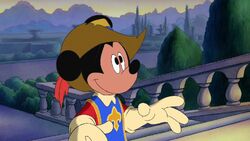
Mickey in Mickey, Donald and Goofy: The Three Musketeers.
When Mickey, Donald, Goofy, and Pluto were children, they were street urchins who were attacked by the nefarious Beagle Boys. Suddenly, three heroic musketeers came to the rescue. One musketeer even gave Mickey his hat as a gift. From that day on, Mickey, Donald, and Goofy dreamed of becoming musketeers, but even as they became adults, they were still just as far from their dream as ever. Now, they serve as janitors for real musketeers, but still keep the dream alive by daydreaming of how great the musketeer life would be.
However, Captain Pete constantly bashes the trio by telling them they'll never be musketeers because Mickey is too small, Donald is a coward, and Goofy's too dumb. Unbeknownst to the trio, Pete is actually plotting to kidnap Princess Minnie Mouse, and take over France as king. To do so, he hires the Beagle Boys to kidnap the princess, but they fail. Out of fear, Minnie demands musketeer bodyguards and Pete hires Mickey, Donald, and Goofy, believing they'll do a terrible job. On their first day, the trio rescues Minnie and her lady-in-waiting Daisy, from the Beagle Boys in yet another kidnap attempt.
After the rescue, Mickey and Minnie fall in love. Meanwhile, Pete plots to get rid of the trio after he realizes they're more trouble than usual. Goofy is lured away from Minnie's castle by Pete's lieutenant Clarabelle and Donald is kidnapped by the Beagles but he is able to escape. When he does, he heads back to the palace to warn Mickey. Mickey attempts to have Donald help him take down Pete, but the duck is too afraid. Donald quits and leaves France, while Pete kidnaps Mickey.
He takes Mickey to Mount St. Michael. There, he is imprisoned in a chamber that will flood with high tide, drowning Mickey. Fortunately, Goofy is freed by the reformed Clarabelle, and Donald decides to rejoin the force. Donald, Goofy, and Pluto head off to rescue Mickey, which they do just in time. Mickey and the gang head to the opera theater where Pete has already managed to take control. A battle follows and Pete is defeated. Mickey and Minnie then proclaim their love, and the trio is dubbed royal musketeers.
Mickey's Twice Upon a Christmas
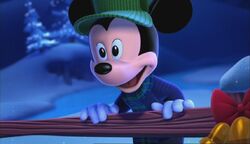
Mickey in Mickey's Twice Upon a Christmas.
In the sequel to Mickey's Once Upon a Christmas, Mickey is first seen attending Minnie and Daisy's ice skating tournament with him and Donald watching. Later on, Mickey is planning a big Christmas party for everyone to enjoy. Although Minnie would rather have him do something simple, Mickey goes ahead and decorates excessively with three animatronic Santa Claus figures, a moving train set around the Christmas tree, and much more. While on the phone with Minnie, Pluto accidentally ruins the decorations, especially knocking down the Christmas tree. With all the decorations destroyed, Mickey has no choice but to go out and get new decorations. Before he leaves, he harshly scolds Pluto and sends him to his dog house. After Mickey departs, Pluto runs away and finds himself at the North Pole, where he's adopted by Santa's reindeer.
Meanwhile, Mickey has returned to redecorate the house. Unlike the previous decorations, these are simpler. After the finishing touches were complete, Mickey went to the dog house to apologize to Pluto for his anger, wanting Pluto to place the star on the tree. Instead of Pluto, Mickey finds his discarded collar, and spots paw prints on the snow, heavily indicating that Pluto has run away. In a panic, Mickey calls Minnie for help and heads out to find his pal. He spends the entire day hanging up posters around the city. During the night, Mickey visits Santa Claus, who is having a meet-and-greet session, and tells him that all he wants for Christmas is Pluto back. But this is no ordinary department store Santa, this is the real deal.
Mickey returns home, with all hope lost. Suddenly, Pluto pops up on the roof of the house and rushes down to Mickey's arms. Just as the 2 begin to reunite, a snow plow truck that nearly ran into Mickey earlier rushes into the front yard of Mickey's house. The driver turns out to be Goofy, accompanied by Max, Minnie, Donald, Daisy, Scrooge McDuck, Huey, Dewey, and Louie. Minnie explains that Scrooge purchased a snow plow company to help find Pluto. Overjoyed with his friends being there, Mickey invites them in, and they all sing Christmas carols to celebrate.
Other films
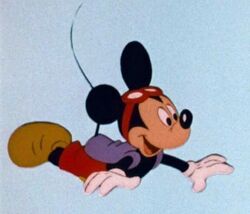
Mickey's cameo in Who Framed Roger Rabbit.
Mickey made several appearances in Who Framed Roger Rabbit. He makes a notable appearance skydiving with Bugs Bunny, in during which the two encounter Eddie Valiant. After the climax, Mickey is seen leading the other toons into the human world to Roger Rabbit and friends. Looking upon the carnage, Mickey ponders the identity of Judge Doom.
In Oliver & Company, Fagin was shown to have a Mickey Mouse watch.
In The Little Mermaid, Mickey is seen in the crowd of merpeople at Sebastian's concert. He can be spotted alongside Donald and Goofy just before King Triton illuminates the coral chandelier.
Mickey made three cameo appearances in A Goofy Movie, first seen in the audience of students at Max's high school's assembly, then hitchhiking with Donald Duck during the song "On the Open Road", and finally as a member of the crowd at the Powerline concert. A Mickey Mouse phone was also seen in Max's bedroom.
In Toy Story, a Mickey Mouse wall clock can be seen in Andy's bedroom.
Steamboat Willie's Mickey makes a cameo appearance as a transformation of Genie's in Aladdin and the King of Thieves.
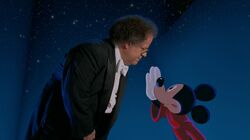
Mickey with James Levine in Fantasia 2000.
In Fantasia 2000, Mickey reappears in The Sorcerer's Apprentice. Afterward, he has a brief exchange with Leopold Stokowski, just like in the original Fantasia, followed by a brief live-action/animation continuation where he tells James Levine to introduce Donald and Daisy's segment, Pomp and Circumstance, before frantically searching backstage for Donald.
Mickey makes a cameo in the end credits of the Teacher's Pet film. He is shown posing with the Helperman family in a photo of a trip they took to Walt Disney World.
In The Lion King 1½, Mickey makes a brief, non-speaking cameo in the form of a silhouette during the film's finale, joined by a cast of various other Disney characters as they prepare to watch the movie all over again.
In Chicken Little, Melvin was shown to have a three-eyed Mickey Mouse watch.
In Wreck-It Ralph, a billboard with artwork of Mickey can be seen in the background of Litwak's Arcade.
In Frozen, a Mickey plush can be seen in the stocks of Wandering Oaken's Trading Post and Sauna whilst Princess Anna is gathering her winter wear.
In Saving Mr. Banks, Mickey is commonly mentioned and alluded to by Walt Disney, significantly during a scene where Walt confesses he was once offered a large payment in exchange for Mickey's rights, and although he had no money to his name, his love for the mouse prevented him from taking the offer stating:
- "I've fought this battle from her side. Pat Powers, he wanted the mouse and I didn't have a bean back then. He was this big terrifying New York producer and I was just a kid from Missouri with a sketch of Mickey, but it would've killed me to give him up. Honest to God, killed me. That mouse, he's family."
In Zootopia, a plush of Mickey is seen in a stroller passing Nick Wilde and Finnick.
In Ralph Breaks the Internet, he appears with his sorcerer outfit at the top of the Disney Animation pavilion at the Oh My Disney website. A plush of Mickey is later seen in a shelf on a quiz-taking girl's bedroom.
In Frozen II, Olaf's charade of a mouse is an impersonation of Mickey.
Television appearances
Walt Disney anthology series
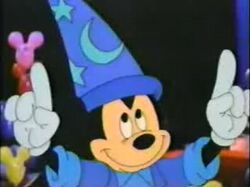
Mickey in Mickey's 60th Birthday.
Mickey was regularly featured in the series, portrayed as a good friend and partner of the show's host, Walt Disney himself, as well as an acclaimed actor for the company.
Mickey was commonly the primary focus of a few episodes but was also heavily featured in episodes centering around Donald (much to the duck's dismay), Goofy, Jiminy Cricket, and others. Some of these episodes include On Vacation with Mickey Mouse and Friends, A Ranger's Guide to Nature, Four Tales on a Mouse, The Donald Duck Story, From All of Us to All of You, The Goofy Success Story, and many others.
Throughout the years, various specials celebrating Mickey's success and history also aired, mostly centered around the mouse's birthday, including Mickey's 50 and most notably Mickey's 60th Birthday, where the story revolved around Mickey Mouse mysteriously disappearing during the anniversary of his debut, resulting in worldwide catastrophe and despair.
The Mickey Mouse Club
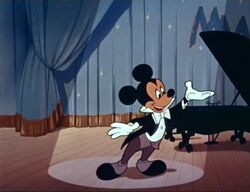
Mickey in a Mickey Mouse Club opening segment.
Mickey was the mascot of the daily variety show. He featured prominently in the opening theme song, in which he donned a marching band outfit while being celebrated by a slew of his supporting cast—with the exception of an envious Donald Duck, who is instead trying to steal the spotlight. The series refers to Mickey as the "leader of the club"—the members of which are referred to as Mouseketeers, whom sport hats modeled after Mickey's round ears.
Throughout the week, an animated segment featuring Mickey kicked off each episode by greeting the Mouseketeer audience and calling the cue to start the show, to the tune of classic Disney songs. On Monday and Tuesday, Mickey appeared as a concert pianist ("A Dream Is a Wish Your Heart Makes") and a vaudevillian actor ("Zip-a-Dee-Doo-Dah"), respectively. On Wednesday and Thursday, he was the sorcerer's apprentice ("The Siamese Cat Song") and a trombone-playing bandleader ("Following the Leader"). Finally, on Friday, he was a cowboy with a western drawl ("Pecos Bill"). Walt Disney reprised his role as Mickey for these animations, partially as a way to prove that he could still pull off the voice.
A classic Mickey Mouse short film would play towards the end of episodes. These were presented as "Mouskartoons", and featured a brief introduction in which Jimmie Dodd would pull a raffle from a place called the "Mickey Mouse Treasure Mine".
Bonkers
Mickey was given a guest spot on Bonkers in "I Oughta Be in Toons". Mickey was kidnapped and was rescued by Bonkers (who idolizes Mickey) and Lucky Piquel. Throughout the episode, Mickey was never actually seen (except as a silhouette in the first scene of the episode) and only referred to as "the Mouse".
Additionally, Mickey was referenced in other episodes of the series—even making a few cameo appearances, though never in-person. In "Of Mice and Menace", the Toon Museum features an exhibit that includes a portrait of Mickey as depicted in Steamboat Willie, alongside the wheel of the titular ship. In Springtime for the Iguana, Bonkers notes that Mickey got his start in "the lowly role of a steamboat captain" (though in the actual short, Pete was the boat's captain) as a means of convincing Roderick Lizzard to portray the role of a monster.
Mickey Mouse Works
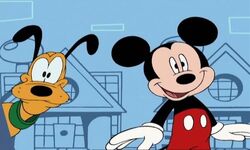
Mickey with Pluto in Mickey Mouse Works.
Mickey was the star of the series similar to his classic cartoons. Mickey usually got into problems out of his own mischievous attitude. Mickey had his own 90-second cartoon segments entitled Mickey to the Rescue in which he would break into Pete's trap-laden hideout to rescue Minnie.
In some episodes, Mickey would be involved in the Ajax business with Donald and Goofy having various jobs often ending in complete failure while in other cartoons might involve him in trying to impress Minnie by going over the top and modern.
Hearkening back to his roots, Mickey was shown to be a trickster in the show, in such shorts as "Mickey's Mountain" and "Mickey's Cabin", usually having Mickey outwit his nemesis, Pete, as they battle each other. He was also reunited with his rival, Mortimer Mouse, for the first time in animation since "Mickey's Rival"; the two would regularly clash throughout the series, beginning in "Mickey's Rival Returns".
House of Mouse
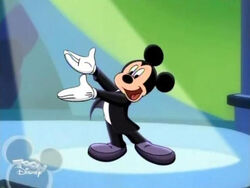
Mickey as the host of House of Mouse.
In Disney's House of Mouse, Mickey is the owner of the eponymous popular night club in downtown Main Street. Mickey strives to keep the club profitable to keep safe from its villainous landlord, Pete. All the while, he must maintain the stability of both his madcap crew. Like his previous series, Mickey's mischief often gets the club into hot water, such as in "Rent Day", where he spent the club's rent on a large order of cheese.
In Mickey's Magical Christmas: Snowed in at the House of Mouse, a snowstorm traps Mickey and the guests inside the club on Christmas Eve. Mickey suggests they throw a Christmas party at the club. While the guests enjoy themselves by watching cartoons and socializing, Mickey and the employees try to get Donald into the Christmas spirit. With the guidance of Jiminy Cricket, Mickey is able to shed light on Donald, making it a merry Christmas for everyone.
In Mickey's House of Villains, Mickey tries to give his guests a good-spirited spooky Halloween. However, things take a turn for the worst when Jafar rallies the villains together and takes over the club. Mickey tries reasoning with Jafar to get the club back to normal, but to no avail. This forces Mickey and his friends to sneak backstage and don his sorcerer robes and hat from his time as Yen Sid's apprentice, and battle Jafar in a magical duel. Jafar manages to overwhelm Mickey, causing the latter to lose his hat and powers. As as the villains prepare to eliminate Mickey, Aladdin provides a lamp to imprison Jafar, scaring the other villains away and returning the club to normal.
Mickey Mouse Clubhouse
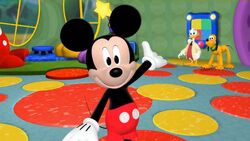
Mickey, as he appears in Mickey Mouse Clubhouse.
Mickey is the host of the computer-animated series in which he uses brains and teamwork to solve problems. Mickey is the leader of the clubhouse gang and often going on various adventures to help and/or save his friends.
In the show, Mickey and the clubhouse gang solve various problems using the viewers help. Aside from leaving on adventures and solving puzzles, Mickey and his friends also go through other problems such as stopping Goofy's Goofbot and Mickey and Pluto spending the day trying to return to solid ground after being trapped in a bubble.
Mickey is also the host of the spin-off television series: Mickey Mousekersize. In these shorts, Mickey, accompanied by Toodles, help his friends stay in shape by using exercises to solve their daily problems. Mickey also appeared in the Christmas, Halloween, and Thanksgiving-themed episodes of Minnie's Bow-Toons.
Mickey Mouse
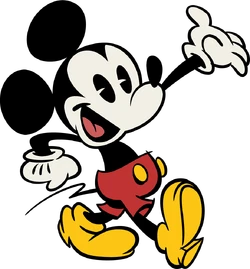
In the animated mini-series, Mickey and his friends are shown having numerous adventures in exotic places around the world, including Paris, Tokyo, New York City, and more. In the series, Mickey retains his rascally persona most prominently featured in the shorts of the 1920s and 1930s. Many of his cartoons revolve around impressing Minnie in one way or another, though the true focus of the episodes revolves around Mickey figuring out comical ways to achieve whatever task is at hand while keeping his lovable nature.
Many episodes focus on Mickey attempting over-the-top methods of wooing Minnie, dealing with Goofy's antics and clashing with Donald's fiery temper and selfishness.
This incarnation features Mickey living either in an apartment in a city or in a suburban home, with an occasional goldfish named Gubbles and Pluto. When shorts are focused in these settings, Mickey tends to take a more down-to-earth approach with things, such as trying to cure Donald of an illness, win a dog show, escape the summer heat or save his goldfish from a hungry cat. At times, though, his adventures can still escalade in his default home, such as the night he ran through the dangerous city streets to save a sleep-walking Goofy, the night he accidentally lost his ears or the time he challenged Pete to a wrestling match, albeit accidentally.
Notably, some cartoons portray him in various roles set around the globe. For example, in "Yodelberg", Mickey is a Swiss mouse who wishes to visit Minnie atop the Matterhorn, but the treacherous terrain may cause such a plan to be difficult. "Tokyo Go" stars Mickey as a Japanese mouse going on an adventure aboard the Tokyo bullet train system. In "O Sole Minnie", Mickey is an Italian mouse struggling to win Minnie's heart.
Mickey Mouse Mixed-Up Adventures
Mickey appears in the animated series, where he and his friends live in a town named Hot Dog Hills, which prides itself in its recurring racing tournaments. Mickey is the head of a local auto garage commanded by himself alongside Minnie, Donald, Daisy, Goofy, Pluto, Chip, and Dale. Mickey's transforming roadster is known as the "Hot Diggity Hot Rod," which in daily driver mode, is the Clubhouse Toon Car from Mickey Mouse Clubhouse.
The Wonderful World of Mickey Mouse
Mickey returns in the TV series that's based off the original Mickey Mouse shorts series. Like it's predecessor, it is an animated mini-series with Mickey and his friends having adventures and overcoming everyday problems. Like in the previous series, Chris Diamantopoulos reprises his voice role of the title character.
Mickey Mouse Funhouse
Mickey appears with his friends with their new friend Funny the Talking House. With Funny's ability to transport people to places around the world, Mickey and his friends go on amazing adventures.
Other shows
In The Mouse Factory, Mickey made recurring appearances in the live-action wrap-around skits alongside the other costumed characters and celebrity guests.
Mickey and Donald appear as statues in the sculptor's cart at one point in the Adventures of the Gummi Bears episode "The Sinister Sculptor".
In 101 Dalmatians: The Series, Mickey makes numerous appearances. When the pups are riding on top of a subway train in the first episode, "Home is Where the Bark Is", Mickey's silhouette can be seen as one of the passengers. In "Roll Out the Pork Barrel", Rolly has a stuffed animal of Mickey Mouse, and in "On The Lamb", one of the trees in the Gruteley Nursery is in the shape of a Mickey Mouse head.
In the anime series Stitch!, Hidden Mickeys are a common running gag in many episodes. In "Stitch, Going to Tokyo Disneyland", Gantu mistook Mickey's likeness for Dr. Hamsterviel.
A Mickey Mouse plush can be seen in Prep & Landing: Naughty vs. Nice.
In the ABC television series Once Upon a Time, several figurines of Mickey and Minnie can be seen, most notably in Mr. Gold's pawn shop. Mickey also inspired the apprentice character who was, at one point, turned into a mouse.
In the DuckTales episode "Moonvasion!", Donald is found stranded on a deserted island with an imaginary friend in the form of a watermelon shaped as Mickey's head.
In the series finale of At Home With Olaf, a short clip of On Ice featuring Mickey and Minnie appears during a montage of heartwarming moments from Disney films playing in Olaf's song "I Am with You".
In WandaVision, Darcy Lewis can be seen wearing a Mickey Mouse watch.[77]
In The Simpsons episode "Bart's in Jail!", the Norse god Loki shapeshifts into Mickey before leaving the titular family to add blackout dates to annual Disneyland passes.
Printed material
Comics
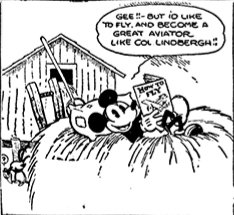
Mickey in the very first panel of his newspaper comic strip.
From 1930 until 1950, though the numbers of the comic creators that worked on Mickey increased, the most popular version (considered the "classic" version today) was that of Floyd Gottfredson, who developed Mickey's character, adopted characters from the cartoons and created many others. Since 1950, the most popular version of Mickey has been that of Italian creator Romano Scarpa, who has further developed Gottfredson's characters and has added many of his own. With the inclusion of comic stories added to Mickey's career, a cast of new characters was created, including the Phantom Blot, Chief O'Hara, Eega Beeva, and Mickey's nephews Morty and Ferdie Fieldmouse. Some of these additional characters would go on to make animated appearances in Mickey Mouse media, such as television and a few of the classic shorts.
Kingdom Keepers
Although Mickey never made an appearance in the Kingdom Keepers books, it's known he is the leader of the Disney characters and is mentioned by Minnie and Ariel in the fourth book, Power Play. Here, they say Mickey disappeared since an event called the night, when strange noises and some kind of struggle were heard from his house at Mickey's Toontown Fair (this is the "reason" why they closed the land). It is eventually learned that his original sketch was torn apart and scattered to keep the Overtakers from finding it, leading to him vanishing.
Video games
- Main article: Mickey Mouse in video games
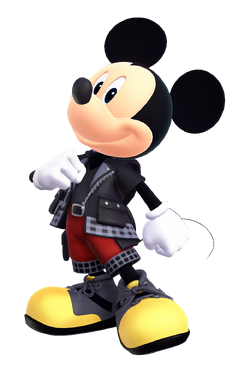
Mickey has starred in many video games, including Mickey Mousecapade on the Nintendo Entertainment System, Mickey Mania: The Timeless Adventures of Mickey Mouse, and the Magical Quest trilogy on the Super Nintendo Entertainment System, Castle of Illusion starring Mickey Mouse on the Sega Genesis, and many others. Mickey made his sixth generation era debut in Disney's Magical Mirror Starring Mickey Mouse, a Nintendo GameCube title aimed at younger audiences.
Mickey is also a major character in the Kingdom Hearts series, taking the role as the king of his world Disney Castle, ruling along side Minnie. In this video game series, he is not the protagonist of the series, but he does assist the protagonist and the rest of his friends being as one of his fellow Keyblade bearers from time to time.
The first game in the Epic Mickey series, featuring a darker version of the Disney universe, was released in 2010 for the Wii. It centers around Mickey's adventures in Wasteland, a world where forgotten and rejected Disney elements and characters reside, including Oswald the Lucky Rabbit.
Mickey Mouse appears in his Sorcerer Mickey form at the beginning of Disney Infinity in the introduction. He is also available as a playable character. He is available in his normal form in the third game, alongside Minnie.[78] The "classic" version has boxing abilities and throwing items, and can summon Goofy, Donald, Pluto, and Oswald. He also has a costume change to turn into King Mickey from Kingdom Hearts. In 2.0 a crystal version of his Sorcerers's apprentice character was made.
Mickey makes a cameo appearance in Nintendo's crossover fighting game, Super Smash Bros. Ultimate, in the form of the keychain bearing his emblem that is attached to Sora's Keyblade.
Disney Heroes: Battle Mode
Mickey appears as a playable and unlockable hero. Currently, his special attack is to attack enemies with a slingshot. He can also use his abilities to transform into the Sorcerer's Apprentice and heal allies. During his victory pose, he turns into his classic black-and-white design.
Disney Parks
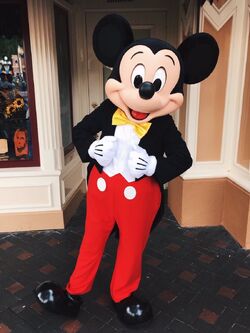
Mickey, posing for a photo in Disneyland.
Ever since Disneyland first opened in 1955, Mickey and the gang have been an important part of the Disney theme park experience. Today, they can be seen everyday in shows, parades, and meet-and-greet opportunities at every Disney theme park, resort, and cruise ship worldwide. Usually dressed in a tuxedo jacket, a yellow bow, long red pants, and black shoes, Mickey is the most requested character in the parks.
A number of the Disney parks feature a "Partners" statue, which depicts Mickey and Walt Disney holding hands as the partners responsible for bringing Disneyland to life.
At the entrance to Disneyland, Magic Kingdom and a few other parks is the Floral Mickey structure, which is an homage to Mickey made entirely of flowers.
Disneyland
At Disneyland Park, Mickey can often be found in Town Square on Main Street USA, as well as in his Movie Barn at Mickey's Toontown. For entertainment, Mickey is seen in almost all of the park's parades as well as in the popular nighttime spectacular Fantasmic!. Mickey often performs with the Disneyland Band as well. He is also the star of the live stage show Mickey and the Magical Map.
Over at Disney California Adventure, Mickey can be found on Buena Vista Street for meet-and-greets. Mickey, in his sorcerer outfit, can be seen at the end of the nighttime spectacular World of Color. In the 2015 rendition of the show, as part of the Disneyland Resort: Diamond Celebration, Mickey serves as a co-host, alongside Neil Patrick Harris. An early segment of the show additionally centers the mouse and his career in animated shorts.
Mickey and Minnie's Runaway Railway features Mickey, Minnie and Pluto going on a picnic while saving passengers from a runaway train.
Walt Disney World
At the Magic Kingdom, Mickey greets guests inside the Town Square Theater on Main Street, U.S.A. Mickey can also be seen in Mickey's PhilharMagic, Mickey's Royal Friendship Faire, the Festival of Fantasy Parade, and other entertainment offerings. In Sorcerers of the Magic Kingdom, Mickey has two spell cards--"Apprentice Mickey's Broomsticks" and "Mickey's Magic Beans".
Over at Disney's Hollywood Studios, Mickey stars in that park's version of Fantasmic! Rizzo the Rat and Waldo C. Graphic impersonate Mickey in Muppet*Vision 3D. Mickey also greets guests in his sorcerer outfit at Streets of America. Mickey and Minnie's Runaway Railway, the first ever ride-through attraction based around Mickey Mouse, is set to open in 2019. The family-friendly dark ride is inspired by the Emmy-Award winning shorts seen on Disney Channel.
At Disney's Animal Kingdom, Mickey hosts meet-and-greets alongside Minnie inside the Adventurers' Outpost on Discovery Island.
At Epcot, Mickey greets guests alongside Minnie, Goofy, and Baymax inside Epcot Character Spot at Innovations.
Mickey also appears at several character dining experiences throughout the property, including Chef Mickey's at Disney's Contemporary Resort, Ohana at Disney's Polynesian Resort, Garden Grill in The Land pavilion at Epcot, Mickey's Backyard Barbecue at Disney's Fort Wilderness Resort and Campground, and Tusker House Restaurant at Disney's Animal Kingdom.
Disneyland Paris
In Disneyland Park (Paris) for meet-and-greets, Mickey can be found on Main Street or at the "Meet Mickey Mouse" greeting spot in Fantasyland. A silhouette of Mickey can be seen in the nighttime spectacular Disney Dreams!. Mickey also stars in the Disney Illuminations fireworks show, which showcases Mickey traversing through various Disney films.
Tokyo Disney Resort
In Tokyo Disneyland, Mickey can be found for meet-and-greets at World Bazaar, Toontown, and Westernland. Mickey also stars in this park's version of Mickey's PhilharMagic. For entertainment, Mickey is featured in One Man's Dream II: The Magic Lives On! and all the parades.
In Tokyo DisneySea, Mickey can be found for meet-and-greets at several locations, including Mediterranean Harbor, American Waterfront, and Lost River Delta. For entertainment, Mickey is featured in Fantasmic!, My Friend Duffy, The Legend of Mythica, and Big Band Beat.
Hong Kong Disneyland
In the park, Mickey appears at the Fantasy Gardens for meet-and-greets, as well as starring in Mickey's PhilharMagic. For entertainment, Mickey appears in the Flights of Fantasy Parade and The Golden Mickeys.
Shanghai Disneyland
The opening of Shanghai Disneyland in 2016 saw the unveiling of Mickey's new facial design, which has a more "animated" appearance. The costume was thusly incorporated into the Florida, Paris, and California parks, thereafter.
As far as appearances, Mickey can be seen in Mickey's Storybook Express, and also stars in the Ignite the Dream fireworks show, which showcases Mickey traversing through various Disney films.
Disney Cruise Line
Mickey frequently makes appearances for meet-and-greets onboard the Disney Cruise Line ships.
Mickey is also part of the Oceaneer Lab with the younger children on board. Mickey is also featured in many of the live stage shows performed on the ships, including The Golden Mickeys, Disney Dreams, and Believe. Mickey also joins in on the Sail Away Parties when the ships are sailing away from their ports.
Mickey also stars in the Pirates in the Caribbean nighttime show, where Mickey and friends host a pirate-themed party, only to be attacked by Captain Hook, Mr. Smee, and his crew.
On the Disney Dream and Disney Fantasy, Mickey is featured in the interactive attraction Midship Detective Agency. Mickey, along with Donald and Goofy, team up with different Disney characters to help solve a case. In one of them based around The Muppets, Mickey is on a lunch break, so he allows Pepe the King Prawn to handle cases for him. He later makes a vocal cameo at the end, and his silhouette can be seen through the door. On the same two ships, Mickey can be seen flying Minnie around in their plane in the magical portholes in some of the guest staterooms.
Relationships

Filmography

Gallery

Trivia
- Mickey Mouse has received ten nominations for the Academy Award for Best Animated Short Film. These are Mickey's Orphans (1931), Building a Building (1933), Brave Little Tailor (1938), The Pointer (1939), Lend a Paw (1941), Squatter's Rights (1946), Mickey and the Seal (1948), Mickey's Christmas Carol (1983), Runaway Brain (1995), and Get a Horse! (2013). Among these, Lend a Paw was the only film to actually win the award. Additionally, in 1932, Walt Disney received an honorary Academy Award in recognition of Mickey's creation and popularity.
- Mickey's ears are always round, no matter which direction he is facing.
- This was the case in the original Kingdom Hearts as well, but was not carried over into future games.
- In "Clarabelle's Big Secret", Mickey confessed that he regularly has his ears starched to keep them round.
- Mickey's size is somewhat inconsistent. The Walt Disney Company's official position is that he is roughly 2 feet and 3 inches tall, as mentioned in this article. However, he is also shown to be the same size as Donald Duck, who, per Carl Barks, is three feet tall. There have also been instances where Mickey is taller than Donald, as was the case in their first cartoon together, Orphan's Benefit.
- There are several recurring gags in Mickey's early cartoons, particularly those of the black-and-white era. These include:
- Mickey whimpering at the camera when something unfortunate befalls him.
- Mickey timidly addressing a masculine authority figure with, "Yes, ma'am."
- Mickey trying to shake Pluto's paw, only for Pluto to pull his paw away in jest.
- A few of Mickey's cartoons feature nods and allusions to the character's real-life inspirations.
- Mickey's role in The Gallopin' Gaucho is an homage to Douglas Fairbanks as the titular character of 1927's The Gaucho.
- Both Charlie Chaplin and Harold Loyd made appearances in Mickey's Gala Premier.
- In Mickey Plays Papa, Mickey briefly caricatures himself as Charlie Chaplin.
- Mickey's dance atop the giant top hat in Thru the Mirror was modeled after the talents of Fred Astaire, whose career was greatly defined by his signature dancing.
- During the 1930s, the Disney Studios had received numerous mail from fans asking to visit "where Mickey Mouse lived". This gave Walt the idea to build what was essentially described as Mickey's home—a small park across from the studio that would feature attractions and statues of Mickey and other Disney characters. The park was dubbed "Mickey Mouse Park". Though the original idea never came to be, the concept evolved into what would eventually become Disneyland.[79]
- Also during the 1930s, according to Walt Disney, Mickey and Minnie Mouse have never been married on screen. But, in 1933, during an interview with Film Pictorial, Walt said, "In private life, Mickey is married to Minnie... What it really amounts to is that Minnie is, for screen purposes, his leading lady." As of right now, the couple is childless in official canon, although Mickey's Nightmare depicts them having 21 children in Mickey's dream. A short clip from their wedding is also in Mickey's dream as well.
- Hidden Mickeys are a common Easter Egg found in Disney films, shows and park attractions. They are silhouettes of Mickey's head, made up of three circles. One of the first Hidden Mickeys was three bubbles that made up Mickey's head in Snow White and the Seven Dwarfs.
- Although Mickey's full name was said to be Michel Mouse in the cartoons, according to the comic La planète des cerveaux ("The Brain Planet"), published in Le Journal de Mickey #2829, Mickey's full name is Michael Theodore Mouse. Michel is the French spelling of the name Michael.
- In the Mickey Mouse cartoon, "The Fancy Gentleman", he is addressed as Michel Francois Mouse by Wadsworth Thorndyke III.
- Mickey Mouse was listed #50 in Empire Magazine's The 50 Best Animated Movie Characters; a list for characters from animated features. The low listing was due to Mickey's lack of critically acclaimed theatrical feature films with the exception of Fantasia. However, the list refers to Mickey as "the world's most famous cartoon character of all time" to make up.
- As the company mascot, many variations of Mickey's silhouette have been used as logos for Disney properties, such as the Disney Channel, Toon Disney (although this channel wouldn't have a logo similar to Mickey's silhouette logo until 2004), and Playhouse Disney.
- Wayne Allwine's final performance of Mickey Mouse before his death was in Kingdom Hearts 358/2 Days. Because of this, there is a dedication to him in the credits of the English version of the game.
- Mickey is usually shown to have magic powers, mainly with the Sorcerer Hat of Yen Sid. It has also been shown that Mickey can control magic without aid—usually in the form of parlor tricks, as was the case in Magician Mickey and "Potatoland".
- In the Walt Disney Parks and Resorts, Mickey is often referred to by the Cast Members as "the boss" or "Mr. Mouse". This is to reflect the fact that Walt Disney and Mickey Mouse are essentially the same person.
- In the 2011 Disney•Pixar film Cars 2, two characters named Mama Topolino and Uncle Topolino are tributes to Mickey, as Topolino (meaning "little mouse") is Mickey's name in Italian.
- In 1933, Mickey Mouse received 800,000 pieces of fan mail.
- In Aladdin, Rajah's face turned into Mickey's for one frame when he transformed from a kitten to a tiger again.
- The original Epic Mickey game showcases Mickey having a certain degree of superhuman strength, being able to break out of metal restrictions.
- Mickey's Social Security number is [[1]], as seen in Runaway Brain.
- In 1945, the producers of the MGM musical Anchors Aweigh wanted Mickey to do a dance number with Gene Kelly and for Walt Disney to animate it. However, the role and dance number were instead given to Jerry Mouse of Tom and Jerry fame and was animated by Bill Hanna and Joe Barbera, who were still making Tom and Jerry cartoons at the time.
- Most of the black-and-white Mickey Mouse cartoons were colorized three times:
- In the late 1960s, a bootleg print of Mickey's Follies mistakenly thought to be in the public domain was part of a package of redrawn cartoons produced by Radio & Television Packagers. This method of colorizing involved tracing almost every frame, coloring them in, shooting the frames over colorized copies of the backgrounds, and in some cases adding new music over a silent film print - making for a stiff, low-quality final product.
- In 1984, when contemplating a deal with CBS to air their cartoons on Saturday mornings, the Walt Disney Company sent more than ten shorts to Entercolor Technologies to get redrawn. Although this deal did not work out, clips of these versions would be shown elsewhere, like on some DTV music videos and the television special Totally Minnie.
- In 1990, American Film Technologies (under a deal with Disney) did computer-colorized versions of approximately 47 Mickey shorts, which preserved the original animation. These digitally-colorized Mickey shorts had aired on anthology shows such as Mickey's Mouse Tracks, Mickey Mouse & Friends, and Donald's Quack Attack on the Disney Channel (and later its sister channel Toon Disney).
- Mickey is mentioned in the Darkwing Duck episode "Comic Book Capers", where Launchpad talks about how Darkwing is starring in his own comic book like Mickey.
- Darkwing Duck comic book writer Aaron Sparrow has noted that he wanted to do a story for the comic that would've had Mickey teaming up with Darkwing to battle the Phantom Blot.[80] Due to Disney cancelling the comic, however, this story is unlikely to ever see print.
- In the fall of 1978, NBC originally aired Mickey Mouse cartoons on the Wonderful World of Disney block for his 50th birthday, 5 years before Disney Channel was launched in 1983.
- Co-producer of the 2017 series DuckTales, Frank Angones, campaigned to have Mickey make an appearance in the series, or at the very least be mentioned. However, Disney executives forbade the team from using Mickey in the show, thus any ideas involving the character were denied.[81] The series was set to potray Mickey as Donald Duck's former college roomate who became more succesful than him.[82] (However, the Phantom Blot, Mickey's nemesis, would make a few appearances in the show's third season.)
- Mickey would only be indirectly referenced in the episode "Moonvasion!", in which a Mickey-shaped watermelon appears as Donald's imaginary companion. Furthermore, Chris Diamantopoulos provided the voice for Donald's ventriloquism of the melon.
- In 2018, a floral structure of Mickey was added to the Miracle Garden in Dubai in honor of his 90th birthday.[83]
- On the day of Mickey's 90th birthday, Tokyo Disneyland's Mickey Mouse meet-and-greet attraction saw an unprecedented 11-hour wait time.[84]
- At the start of the Simpsons short Playdate with Destiny, we see what is presumably Mickey Mouse's silhouette, only to be revealed as Homer Simpson holding two donuts above his head.
- In The Muppet Show episode guest-starring Petula Clark, there was a character named Mickey Moose, whose name is a spoof of Mickey Mouse.
- In Italian version, Mickey was renamed Topolino, which comes from Topo, The Italian word for Mouse.
References
- ↑ Robert Griggs Instagram
- ↑ "The Chemistry Between Walt and Mickey". The Walt Disney Family Museum.
- ↑ 3.0 3.1 "Happy Birthday, Mickey Mouse! Fun facts about everyone's favorite mouse". ABC News (November 17, 2017).
- ↑ "Mickey Mouse : World's Most Famous Rodent Nears 60, and He's Had More Lives Than a Cat". LA Times (November 13, 1988).
- ↑ "The Golden Age of Mickey Mouse". The Walt Disney Family Museum.
- ↑ "The Charlie Chaplin Connection Part Two: Mickey as Chaplin". Mouseplanet (August 24, 2016).
- ↑ Honorary Academy Award to Walt Disney for the creation of Mickey Mouse
- ↑ For Lend a Paw
- ↑ For Mickey's Orphans, Building a Building, Brave Little Tailor, The Pointer, Squatter's Rights, Mickey and the Seal, Mickey's Christmas Carol, Runaway Brain, and Get a Horse!
- ↑ 10.0 10.1 "It Wasn't Always Magic : Fifty years ago, Walt Disney dreamed 'Fantasia' would make animation an artform, but it wasn't a legend in its own time". ABC News (October 7, 1990).
- ↑ Spotlight Talk Recap: The Latin America Tour
- ↑ To Wayne Allwine for Best Recording For Children (Mickey's Christmas Carol, 1977)
- ↑ To Chris Diamantopoulos for Outstanding Character Voice-Over Performance (Mickey Mouse, 2014)
- ↑ To Get a Horse! for Best Animated Short Subject (2014)
- ↑ To Chris Diamantopoulos for Outstanding Achievement for Voice Acting in an Animated Television/Broadcast Production (Mickey Mouse, 2014, 2018, and 2019)
- ↑ 16.0 16.1 Symphony Hour
- ↑ "Mickey and the Culture Clash"
- ↑ Description from the 1938 Disney Christmas card featured "Monsieur Michel Mousse"
- ↑ The Fancy Gentleman
- ↑ Mickey's Kangaroo
- ↑ Mickey's Elephant
- ↑ The Birthday Party, Mickey Steps Out, The Pet Store, Puppy Love, Mickey's Surprise Party, Mr. Mouse Takes a Trip, The Little Whirlwind, The Nifty Nineties, Mickey's Birthday Party, You, Me and Fifi
- ↑ The Chain Gang, The Shindig, Mickey Cuts Up, Camping Out, Mickey's Once Upon a Christmas
- ↑ Mickey's Surprise Party
- ↑ https://inducks.org/story.php?c=YM+133
- ↑ https://inducks.org/story.php?c=YM+065
- ↑ https://inducks.org/story.php?c=YM+069
- ↑ Giants in Their Time: Representative Americans from the Jazz Age to the Cold War, Page 150
- ↑ "'New' Mickey: Big Cheese of 'MouseWorks'". Los Angeles Times (April 30, 1999).
- ↑ "Immersed in Movies: Lauren MacMullan Goes Deeper into Mickey Mouse and 'Get A Horse!'". Indie Wire (August 23, 2013).
- ↑ Mickey Mouse to Star in New Cartoon Shorts with Classic Comedy, Contemporary Flair
- ↑ Walt Disney Treasures: Mickey Mouse in Black and White, Bonus Features - Frank and Ollie... and Mickey
- ↑ "Walt Disney's Oscars®". The Walt Disney Family Museum.
- ↑ World's 25 Most Successful Media Franchises, and How They Stay Relevant
- ↑ "Mickey's First Love: Minnie". Walt Disney Family Museum (February 14, 2013).
- ↑ "Gulliver Mickey"
- ↑ "Disney Character Training - Mickey Mouse". YouTube (March 18, 2017).
- ↑ The Charlie Chaplin Connection Part Two: Mickey as Chaplin
- ↑ Mickey Mouse : World's Most Famous Rodent Nears 60, and He's Had More Lives Than a Cat
- ↑ Building a Building, On Ice
- ↑ The Prince and the Pauper
- ↑ "Hickory Dickory Mickey", "Goofy's Grandma"
- ↑ "Mickey's Cabin"
- ↑ "Split Decisions"
- ↑ "Daisy's Road Trip", "Third Wheel"
- ↑ Get A Horse!
- ↑ Magician Mickey, "Mickey's April Fools"
- ↑ Mickey's Dog-Gone Christmas
- ↑ The Band Concert
- ↑ Apgar, G. (2014). A Mickey Mouse Reader.
- ↑ Tony Thomas Interviews Walt Disney
- ↑ Disney Family Album No. 11: April 1985: Frank Thomas
- ↑ Working with Walt: Interviews with Disney Artists, by Don Peri
- ↑ http://www.intanibase.com/shorts.aspx?shortID=214&studioID=1
- ↑ http://www.disneyshorts.org/shorts.aspx?shortID=214
- ↑ https://www.mouseplanet.com/9360/A_New_Mouse_Voice_In_Town
- ↑ https://www.mouseplanet.com/8820/Mickey_Mouse_Theater_of_the_Air
- ↑ http://cartoonresearch.com/index.php/spin-special-stan-freberg-records/
- ↑ http://www.mousevinyl.com/content/dickens-christmas-carol-disneyland-records
- ↑ http://disneylandrecords.com/disney-christmas-records/3811/index.html
- ↑ A Disney Discography
- ↑ Character Records by Steve Burns - StartedByAMouse.com Features Section
- ↑ http://childrensrecordsandmore.blogspot.com/2008/06/talking-mickey-mouse-readalong-books.html
- ↑ http://voicechasers.com/database/showprod.php?prodid=3382
- ↑ Tony Thomas Interviews Walt Disney
- ↑ Selling Mickey: The Rise of Disney Marketing
- ↑ When Mickey's Career Turned a Page
- ↑ "Today in Disney History: Mickey's Comic Debut". Disney Parks Blog (January 13, 2015).
- ↑ Walt Disney Rare BBC TV Interview Broadcasted 6th July 1959
- ↑ Korkis, Jim (June 5, 2013). "The REAL Lost Mickey Mouse Cartoons" (Article). Mouse Planet.
- ↑ 'Fantasia'
- ↑ THE MEN AND THE MOUSE 60 YEARS LATER, ANIMATORS RECALL HOW MICKEY CAME TO LIFE
- ↑ A Mickey Mouse Reader by Garry Apgar
- ↑ Hulett, Steve (December 4, 2014). Mouse In Transition: An Insider's Look at Disney Feature Animation. Theme Park Press. pp. 17–21, 60. ISBN 978-1941500248
- ↑ Harmetz, Aljean (August 27, 1984). "Animation Again a Priority". The New York Times
- ↑ "He doesn't age. He looks the same as he did years ago." —Mike Breen on Mickey Mouse
- ↑ "WandaVision: Kat Dennings Draws Attention to Darcy Lewis' Disney Watch". comicbook. Retrieved on February 11, 2021.
- ↑ Welcome Mickey and Minnie
- ↑ [https://www.waltdisney.org/blog/disneyland-quintessential-classics-mickey-mouse Disneyland, The Quintessential Classics: Mickey Mouse!]
- ↑ "Comic Q&A: Ask The Professionals", The Old Haunt: A Darkwing Duck forum
- ↑ Mickey Mouse in 2017's DuckTales
- ↑ Frank Angones' Twitter
- ↑ "Dubai Miracle Garden unveils Mickey Mouse tribute display". Arabian Buisness (March 9, 2018).
- ↑ Mickey Mouse fans warned of 11-hour queue to meet him in Japan
External links
| v - e - d | ||||||||
|---|---|---|---|---|---|---|---|---|
|
| v - e - d | ||||||||||||||
|---|---|---|---|---|---|---|---|---|---|---|---|---|---|---|
|
| v - e - d | ||||||||||
|---|---|---|---|---|---|---|---|---|---|---|
|
| v - e - d | ||||||||||||
|---|---|---|---|---|---|---|---|---|---|---|---|---|
|
| v - e - d | ||||||
|---|---|---|---|---|---|---|
|
| v - e - d | ||||
|---|---|---|---|---|
|
| v - e - d | ||||||||||||
|---|---|---|---|---|---|---|---|---|---|---|---|---|
|
| v - e - d | ||||||||||||||||||||
|---|---|---|---|---|---|---|---|---|---|---|---|---|---|---|---|---|---|---|---|---|
|
| v - e - d | ||||||||||
|---|---|---|---|---|---|---|---|---|---|---|
|
| v - e - d | ||||||||||
|---|---|---|---|---|---|---|---|---|---|---|
|
| v - e - d | ||||||||||||||
|---|---|---|---|---|---|---|---|---|---|---|---|---|---|---|
|
| v - e - d | ||||||||
|---|---|---|---|---|---|---|---|---|
|
| v - e - d | ||||||||||||||
|---|---|---|---|---|---|---|---|---|---|---|---|---|---|---|
|
| v - e - d | ||||||||||||||||||
|---|---|---|---|---|---|---|---|---|---|---|---|---|---|---|---|---|---|---|
|
| v - e - d | ||||||||||||
|---|---|---|---|---|---|---|---|---|---|---|---|---|
|
| v - e - d | ||||||||||||
|---|---|---|---|---|---|---|---|---|---|---|---|---|
|
| v - e - d | ||||||||||||
|---|---|---|---|---|---|---|---|---|---|---|---|---|
|
| v - e - d | ||||||||
|---|---|---|---|---|---|---|---|---|
|
| v - e - d | ||||||||||
|---|---|---|---|---|---|---|---|---|---|---|
|
Walt Disney And Mickey Mouse Pictures
Source: https://disney.fandom.com/wiki/Mickey_Mouse
Posted by: johnwasion.blogspot.com

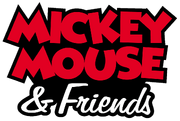

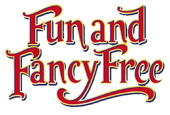
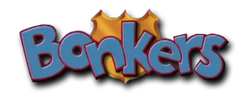
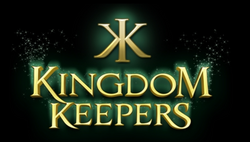

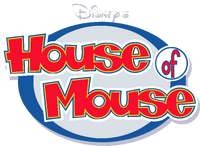
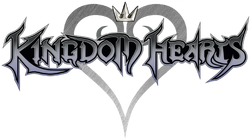

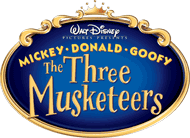
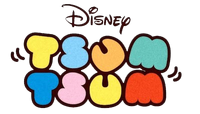
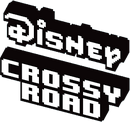
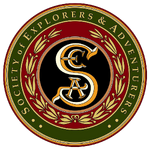
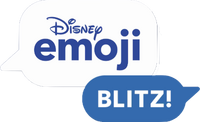
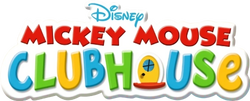

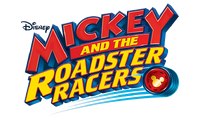

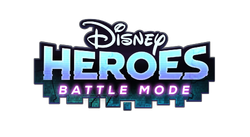
0 Response to "Walt Disney And Mickey Mouse Pictures"
Post a Comment